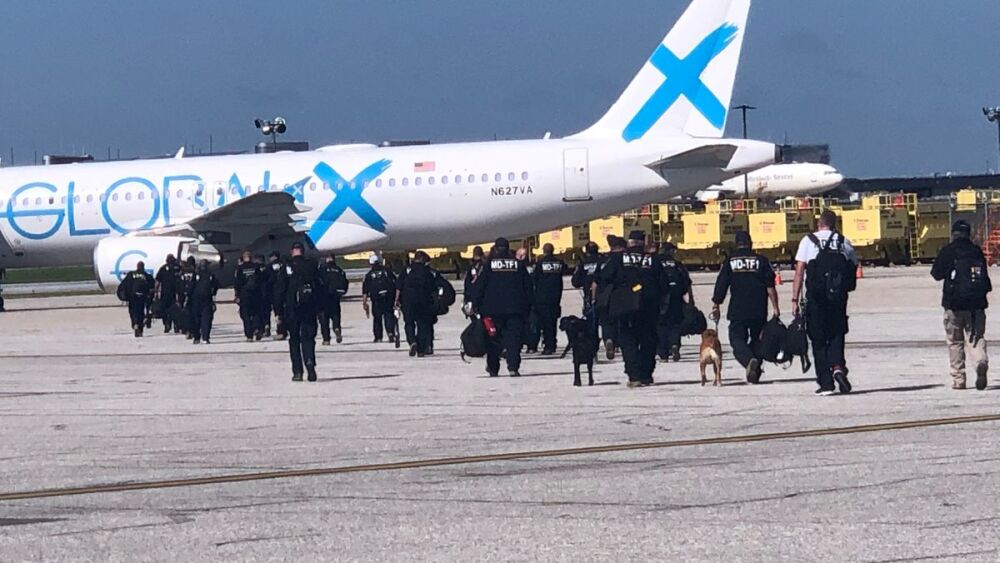Following Hurricane Fiona’s thrashing of Puerto Rico, FEMA dispatched search and rescue task force teams to the area. Amid the rescue and recovery efforts, I had the opportunity to speak to a few individuals from Puerto Rico who are not only U.S. citizens but also volunteer firefighters. They both have personal connections to one of the cities inundated by rain.
Imagine getting nearly 30 inches of rain in a day and a half. Now add 100+ mph winds and an already weakened infrastructure from Hurricane Maria five years prior, and you’ll have just a sense of what’s going on in Puerto Rico.
Making the connection
Through intermediary translators, I was able to communicate with Zone 9 Emergency Management Officer (EMO) Marcos Alexis Haddock Colon to get a feel for what island residents and SAR crews are facing. The translators – Jose De Leon and Racheal Louzau – are originally from Puerto Rico and currently serve as volunteer firefighters in Louisiana and Florida. Jose and Racheal were civil defense, Red Cross, and Salvation Army volunteers and firefighters who met during training in Puerto Rico in the 1980s. Jose volunteered with Civil Defense in Zone 9 in Guayama City. Jose and Racheal helped us gather information from the local firefighters and EMO Colon, the night-shift EMO, who provided insight to what the area is going through.
Emergency management in Puerto Rico
Zone 9 is composed of nine towns that are in the sector or district of Guayama, surrounding the city of Guayama, on the island’s Caribbean coast. Guayama lies just north of where Hurricane Fiona’s eyewall tracked and east of where the storm turned and struck the island. As we have seen from previous storms, the northeast corner typically receives the worst of these storms.
The emergency management functions on the island are connected through FEMA, handled similarly to what we experience on the mainland – locals reporting up to the “state,” which then reports up to FEMA. Colon noted that Puerto Rican officials are accustomed to working on their own for extended periods until additional personnel and resources from the mainland can arrive.
According to the U.S. Census, the Guayama metropolitan area is home to approximately 68,000 residents, with about 44,000 in Guayama City proper. The city maintains one fire station to cover 65 square miles (you read that correctly), providing coverage with four or five firefighters, 24/7. For some comparison, the District of Columbia is comprised of 68 square miles, and has 44 fire stations, with 10 times the population.
At both the city and island level, the EMO works side by side with the Bomberos of Puerto Rico paid firefighters. Six of the other cities and towns in the Guayama sector/division provide support and mutual aid as available to Guayama City. The EMO provides volunteer support through Community Emergency Response Teams (CERT) to assist the fire departments with search and rescue during these events. The EMO volunteers and firefighters work side by side, under the fire department supervision.
Conditions on the ground
Power has been out since Saturday in many areas. At one point, the entire island was reportedly without power. The power grid remains weak and vulnerable, especially after the 2017 battering from Hurricane Maria. Only occupancies with generators currently have power, and potable water is at a premium.
Like most waterways, the Guamani River could not handle 30 inches of rain so quickly. Local residents have reported the Guamani River has overflowed its banks many times. This is a low-lying area coming out of the highlands at the coastal region. Neighbors reported to Colon that this is the first time in history where homes have been swept away by the river’s rage. At the time of this writing, four homes have been washed away. Amazingly, there have been no reported fatalities in this district. Fortunately, residents had been evacuated prior to the flooding. At the height of the storm, 58 families had taken refuge in a local school serving as a public shelter. It is only presumed that other residents took refuge with friends or relatives at higher grounds.
Paid and volunteer firefighters worked together to answer hundreds of calls for rescues. Colon was frank when he relayed that they “lost count” of how many calls they received. The stories of angst and the heroism on the island are overwhelming, he said. In one example, firefighters removed a mother and her three teenage children from a flooded home in Guayama, one of the countless rescues local firefighters have been making since Saturday. They welcome the task force team help.
What’s next
The primary focus for emergency management will be restoring the basic needs of food, power, water and sewer services for the communities. Followed by services and supply availability, then other infrastructure and roadway restoration, there is plenty of work ahead. Fire departments will continue to respond to calls and work with local officials to help restore normalcy.
The island residents are battered, but resilient.
There’s still about 45 days left in the official Atlantic hurricane season. Puerto Rico and the other Caribbean locales constantly sit within hurricane alley. We can only pray that our brothers and sisters in Guayama, and all of Puerto Rico and the other affected islands, have time to rest and recover before facing their next natural disaster.
Read more
On the ground in Puerto Rico with Maryland’s Task Force 1
What to expect as task forces deploy to hurricane ravaged areas














